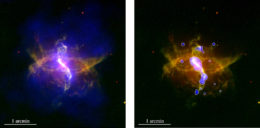
Left: XMM-Newton X-ray observations (blue) overlaid on optical observations (red and green). Right: X-ray emission detected by the Chandra X-ray Observatory (blue) overlaid on the same optical image. Click to enlarge. [Toalá et al. 2022]
A symbiotic star is a close binary system containing a red giant and a white dwarf. One such system, R Aquarii, has been the subject of extensive investigations due to its location — just 1,255 light-years away — and the intriguing filamentary structure of the nebula that surrounds it. The blue areas in the images above and to the right represent the nebula’s 0.3–0.7 kiloelectronvolt X-ray emission, while the green and red areas show the optical emission. Early observations of this object found that the X-ray emission was concentrated at the center of the nebula as well as in clumps of material arranged along a jet-like structure, but a new analysis of archival X-ray Multi-Mirror Mission (XMM-Newton) observations led by Jesús Toalá (National Autonomous University of Mexico, Morelia Campus) has revealed extended X-ray emission associated with the nebula for the first time. Toalá and collaborators suggest that the diffuse X-ray emission arises when outflowing jets create regions of hot gas that are later disrupted, similar to the behavior of hot bubbles of gas blown by the supermassive black holes at the centers of galaxies. To learn more about the complex structure of the gas surrounding R Aquarii, check out the full article below.
Citation
“An XMM-Newton EPIC X-Ray View of the Symbiotic Star R Aquarii,” Jesús A. Toalá et al 2022 ApJL 927 L20. doi:10.3847/2041-8213/ac589d

